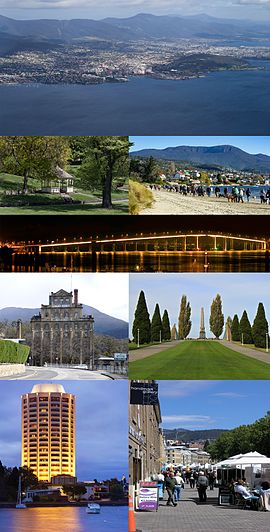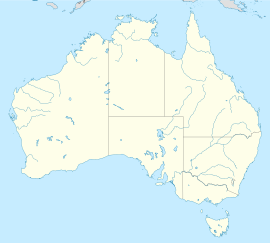Hobart Town
|
Hobart Tasmania |
|||||||
|---|---|---|---|---|---|---|---|

Top, from left to right: Hobart from the air, a gazebo in Royal Tasmanian Botanical Gardens, Sandy Bay beach, Tasman Bridge, Cascade Brewery, Hobart Cenotaph, Wrest Point Hotel Casino, Salamanca Market
|
|||||||
| Coordinates | 42°52′50″S 147°19′30″E / 42.88056°S 147.32500°ECoordinates: 42°52′50″S 147°19′30″E / 42.88056°S 147.32500°E | ||||||
| Population | 221,000 (2015) (11th) | ||||||
| • Density | 124.8/km2 (323/sq mi) (2011) | ||||||
| Established | 20 February 1804 | ||||||
| Area | 1,695.5 km2 (654.6 sq mi) | ||||||
| Time zone | AEST (UTC+10) | ||||||
| • Summer (DST) | AEDT State: Tasmania. (UTC+11) | ||||||
| Location |
|
||||||
| State electorate(s) | Denison, Franklin | ||||||
| Federal Division(s) | Denison, Franklin | ||||||
|
|||||||
Hobart (![]() i/ˈhoʊbɑːrt/) is the capital and most populous city of the Australian island state of Tasmania. With a population of approximately 221,000, it is Australia's least populated state capital. Founded in 1803 as a penal colony, Hobart is Australia's second oldest capital city after Sydney, New South Wales. The modern history of Hobart (formerly 'Hobart Town', or 'Hobarton') dates to its foundation as a British colony in 1803. Prior to British settlement, the area had been occupied for possibly as long as 35,000 years, by the semi-nomadic Mouheneener tribe, a sub-group of the Nuennone, or South-East tribe. The descendants of the indigenous Tasmanians now refer to themselves as 'Palawa'.
i/ˈhoʊbɑːrt/) is the capital and most populous city of the Australian island state of Tasmania. With a population of approximately 221,000, it is Australia's least populated state capital. Founded in 1803 as a penal colony, Hobart is Australia's second oldest capital city after Sydney, New South Wales. The modern history of Hobart (formerly 'Hobart Town', or 'Hobarton') dates to its foundation as a British colony in 1803. Prior to British settlement, the area had been occupied for possibly as long as 35,000 years, by the semi-nomadic Mouheneener tribe, a sub-group of the Nuennone, or South-East tribe. The descendants of the indigenous Tasmanians now refer to themselves as 'Palawa'.
Since its foundation as a colonial outpost, the city has grown from the mouth of Sullivans Cove to stretch in a generally north-south direction along both banks of the Derwent River, from 22 km inland from the estuary at Storm Bay to the point where the river reverts to fresh water at Bridgewater. Hobart has experienced both booms and busts over its history. The early 20th century saw a period of growth on the back of mining, agriculture and other primary industries, and the loss of men who served in world wars was counteracted by an influx of immigration after World War II. In the later years of the 20th century, migrants increasingly arrived to settle in Hobart from Asia. Despite the rise in migration from parts of the world other than the United Kingdom and Ireland, the population of Hobart remains predominantly ethnically Anglo-Celtic and has the highest percentage per capita of Australian born residents among the Australian capital cities.
...
Wikipedia

